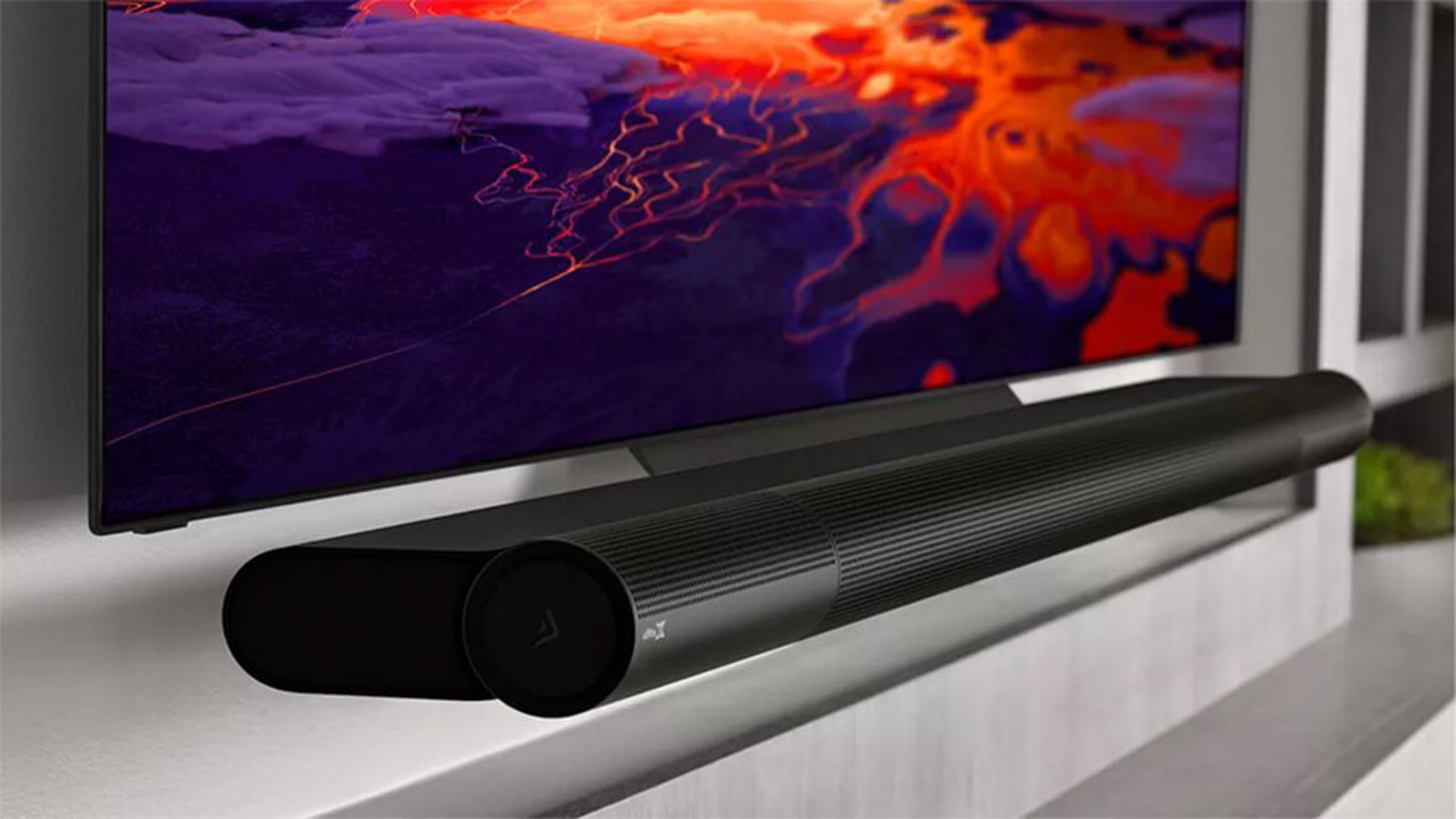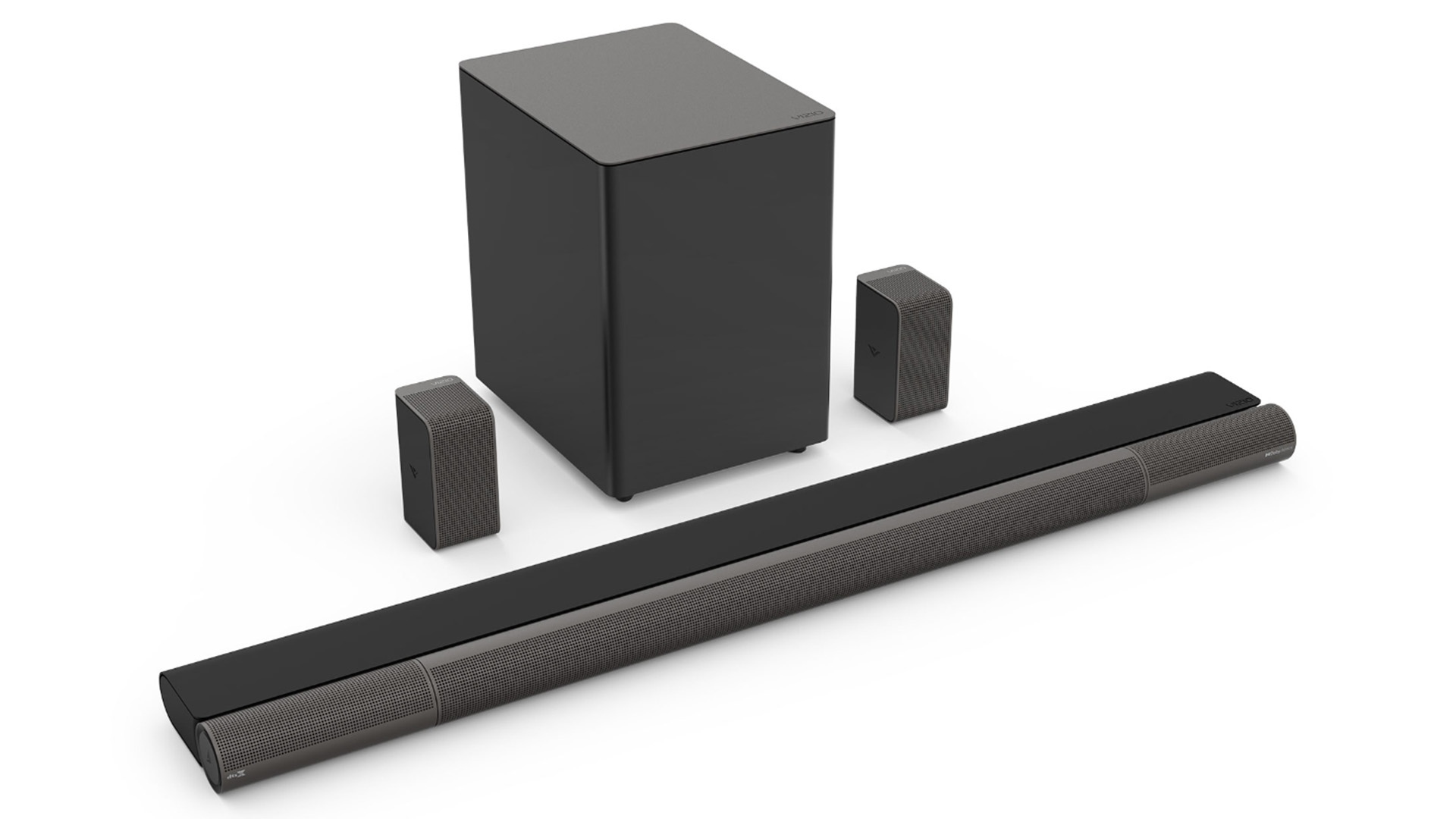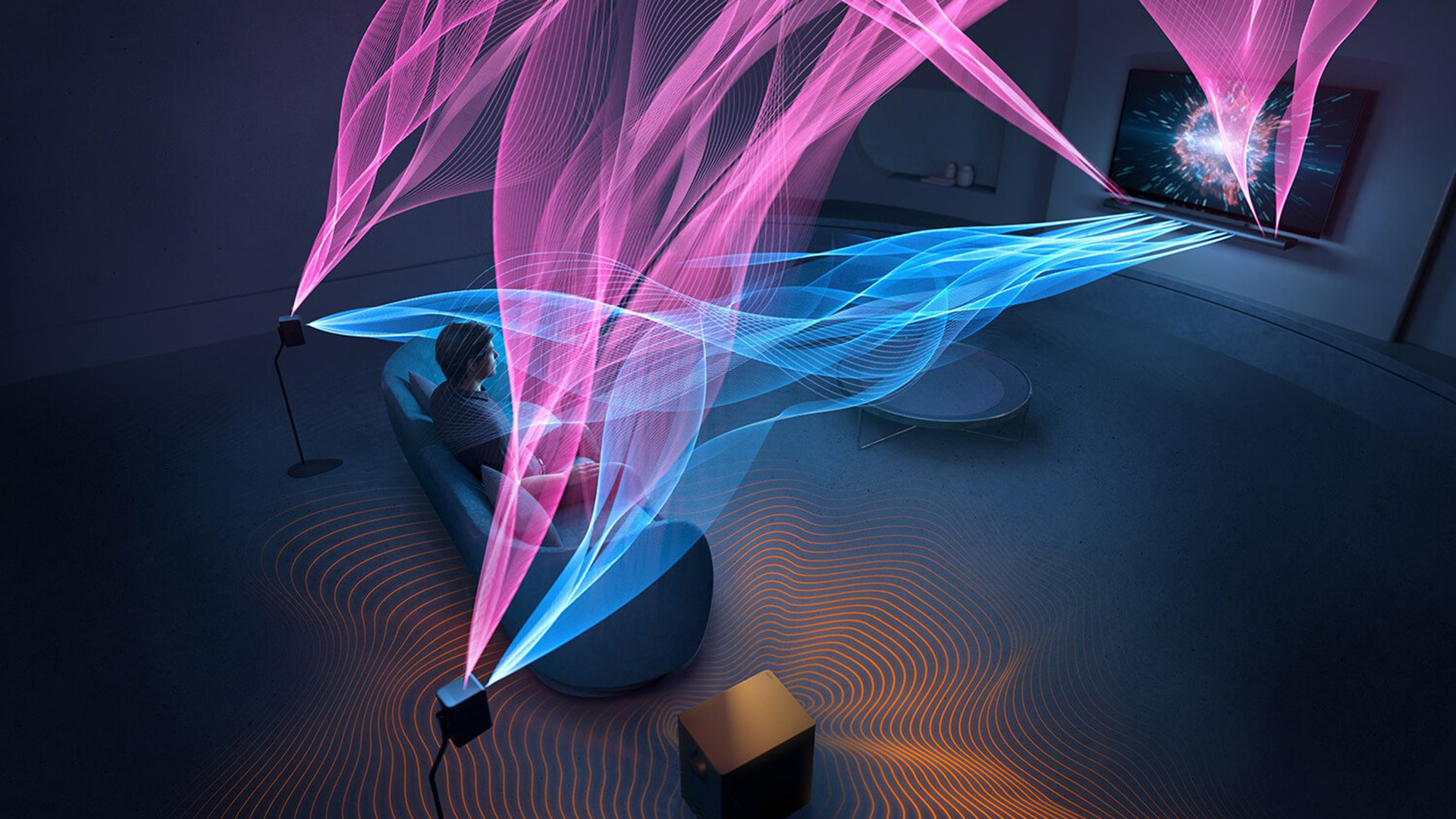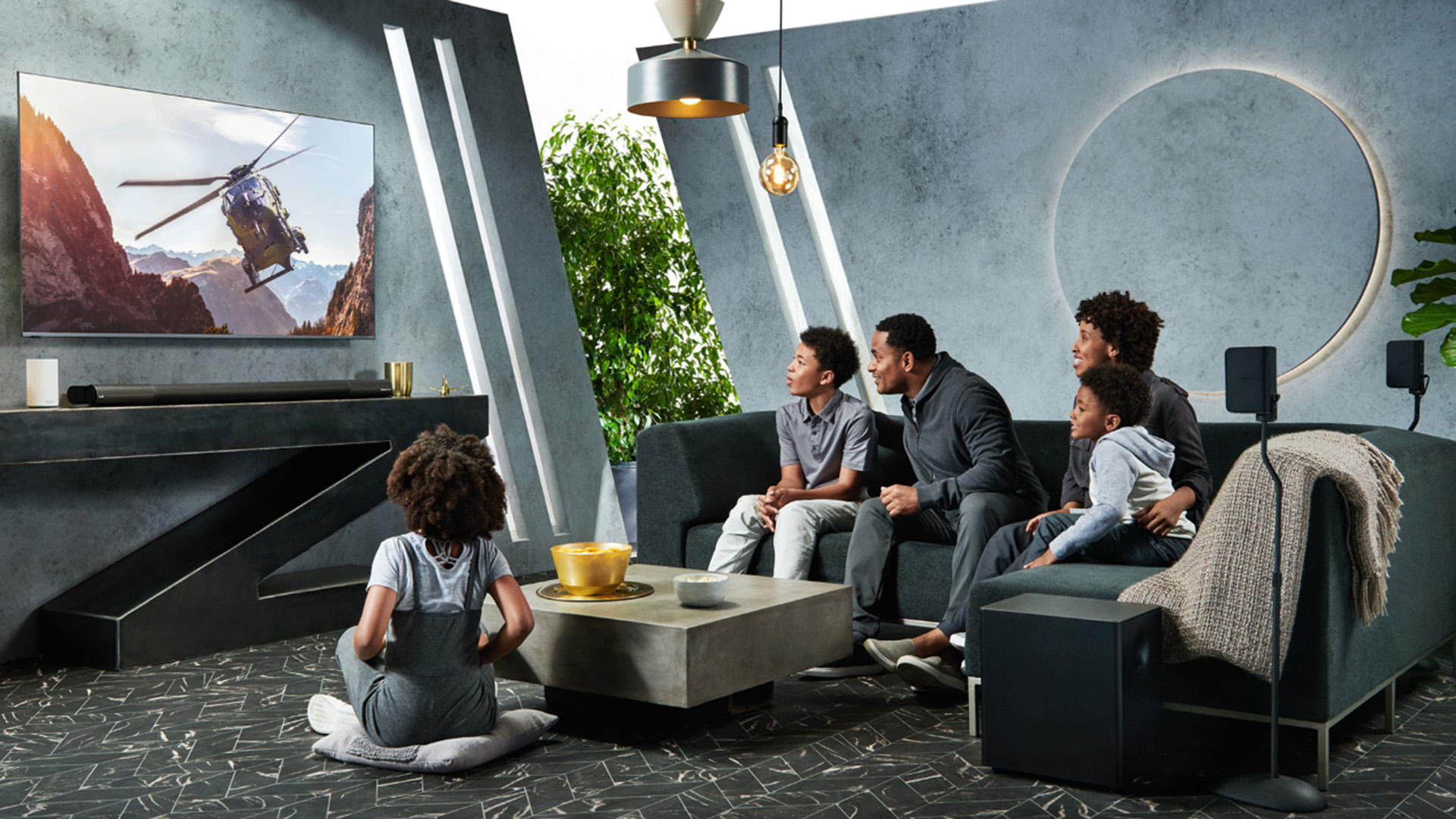Vizio Elevate review: A big, brash 5.1.4 soundbar plus system
Rotating front drivers help deliver a more immersive surround sound experience


The Vizio Elevate is a painless way to bring true 3D Dolby Atmos sound to your living room, at a reasonable price.
-
+
True Dolby Atmos surround sound
-
+
Solid musicality for streaming tunes
-
+
Competitive price
-
-
Proper setup takes some tweaking
-
-
Large subwoofer is hard to hide
Why you can trust T3

With a pair of satellite speakers in tow and motorized drivers upfront, Vizio's Elevate is more than just a run-of-the-mill soundbar. Yet, it's not a full-fledged 7.1 channel surround sound setup, either. What it is, is an excellent hybrid offering superior sound – and sound effects – compared to some of the best soundbars, while delivering audio fidelity comparable to systems costing hundreds of dollars more.
The $999.99 (£720/AU$1293) Vizio Elevate is the TV maker's top-of-the-line sound system, an acknowledgment that if you want the complete movie experience, you need to add a solid audio package to your big flat-panel set. It is a rather standout effort in the crowded field of soundbars, with Dolby Atmos and DTS:X skills that bring blockbusters and dramas alike to life. In our tests, the Vizio Elevate proved to be unquestionably sonically superior to soundbar-only designs, like the $799 Sonos Arc. Moreover, it delivered a more realistic and immersive sound experience than more expensive competitors, such as the Samsung HW-Q900T 7.1.2 Channel Soundbar with Dolby Atmos / DTS and the LG SN10YG 5.1.2 Channel High Res Audio Sound Bar with Dolby Atmos.

Vizio Elevate's full 5.14 speaker set
Vizio Elevate review: Design and Setup
The Elevate is a so-called 5.1.4 home theater surround sound system. For the uninitiated, it means it has 5 main channels (three up front in the soundbar and two satellite speakers in the back), plus a separate subwoofer for the lower bass range (the point 1), and 4 overhead channels. It's that last number that delivers the 3D effects of Dolby Atmos, with birds chirping overhead in forest scenes and rockets roaring by in less bucolic sequences. And it also this feature that has attracted the most attention in the Elevate system because of its unusual design: the two front side speakers in the soundbar are motorized so that they will rotate upward so that sound effects can bounce off your ceiling. And it's not just a gimmick; it can be quite effective with the right soundtrack.
In total, the entire Vizio Elevate package has 18 speaker drivers housed in 4 separate enclosures: a 48-inch wide soundbar that sits under your TV, a subwoofer that wirelessly connects to the soundbar and 2 rear satellite speakers connected by cables to the subwoofer.
It sounds more complicated than it is. It took me 10 minutes to plug it all together; figuring out how to open the box was more time-consuming. There are 3 HDMI inputs on the soundbar, including one for HDMI ARC (audio return channel), which allows it to sync up automatically using a compatible port on your TV. Using the supplied remote control there's also a speaker test you can run once it's powered up. It delivers a spoken voice sound off: "left front," "right rear," etc., to confirm you've connected and positioned everything correctly (in my haste I had swapped the rear speakers so it proved to be helpful).
Should want to do more, the Elevate has plenty of other connections. There's an analog mini-jack input, optical input, Wi-Fi, and it works with Bluetooth wireless sources (a feature lacking in some competitors, like the Sonos Arc). The system also has Chromecast built-in, but not Airplay.
Dressed in unassuming black, the system is relatively inconspicuous. The soundbar is 2.64-inches thick, so it will slide under most big screens on a tabletop. However, paired with a 65-inch Vizion Quantum X I was also testing, I discovered the soundbar's 48-inch width was just a touch too much to fit between the set's legs.
Get all the latest news, reviews, deals and buying guides on gorgeous tech, home and active products from the T3 experts
While you don't have to run cables across the room from the subwoofer to the soundbar, it's a bit of a challenge to hide the subwoofer. It's 11 by 14 by 16 inches, a larger-than-average big black box we had to "conceal" next to a coffee table; it certainly won't fit behind a couch.

That full sound stage makes use of the side speakers bouncing sound off the ceiling.
Vizio Elevate review: Sound Quality
Situated in a large 18 by 20-foot room with double-height ceilings, the Vizio Elevate was easily able to fill the space with dinosaur roars and bellowing superheroes. (Vizio says it can deliver 107 dB of sound pressure.) Out of the box, I found the system too bass-heavy, rattling the floor in the nearby kitchen (the subwoofer is rated to go down to 30 Hz). The remote makes it possible to adjust most settings, though finding them all takes some study of the user's manual.
There are preset EQ modes on the remote control for movie, music, and gaming, for example. But adjusting the balance of, say, the center channel for dialogue is under "Levels" on the remote. Also adjustable are the overall bass and treble levels, and subwoofer and satellite speaker balance. I also tweaked the height level adjustment so those rotating speakers could take better aim at my higher ceilings.
For standard movies with surround sound, the Vizio Elevate was more than up to the task. In the 2005 version of King Kong, the bi-planes swirling around Kong on the Empire State Building were thrilling. The machine guns seemed to come straight at us with the sound of propellers clattering around our heads.
In Dolby Atmos, The Hobbit: The Desolation of Smaug sounded like Peter Jackson would appreciate. From the center channel grunts of orcs to the stereoscopic peel of an elf's horn, the soundtrack comes through splendidly. The orchestral flourishes of the music seemed to be capably handled by the satellites. Two scenes particularly stood out: the one with barrel-riding dwarfs tumbling down the shoreline and then into the water had burbling and rushing water all around us and when the fish were dumped on their heads, it felt like the smelts were falling on us.
Furthermore, the latest streaming monster mash, Godzilla vs. Kong, fared very well, too. From navy vessels being bashed into underwater Kong screams, the sound effects seemed thrilling and able to do as intended – draw you into the action. In the Vizio Elevate's default Movie mode, I found I had to adjust the volume of the dialogue and center channel to bring the actors up into the forefront – without driving the volume to ear-splitting levels.
To really judge the Vizio Elevate's sonic abilities, I auditioned a wide variety of hi-res tracks from jazz and rock to classical pieces. With prog rock from Yes, I found a lot of the lower midrange instruments emanate directly from the front soundbar, with higher notes, such as those from Steve Howe's acoustic guitar at the opening of Roundabout coming from the satellites. All the while Rick Wakeman's keyboards swirl all around you.
I did find myself switching EQ settings between Movie and Music on the remote. Listening to a hi-res version of David Bowie's Pinups demonstrated some interesting differences. Movie mode gives the sound some artificial high-end bursts and accentuates more extraneous sounds originally buried in the mix (like background cymbals). Switching to Music mode definitely improves things flattening out the sound and keeping it more balanced and faithful to the original mix – although it will seem to most listeners as if you just muted the volume.
As for more classical music works, the Vizio Elevate performed surprisingly well. Bach's Toccata and Fugue in D Minor (Simon Preston) had a wonderful limpidness to the upper ranges of the pipe organ, and the very low end was fine. But there was something oddly lacking in the midrange of the keys. Beethoven's Eroica (Jordi Savall) was actually very pleasing, handling violin and piccolo with equal skill. But then we had to boost the bass levels back to bring out the thundering timpani rolls.
Can the Elevate supplant a solid dedicated stereo system? Probably not for critical listeners. Astute classical fans will detect a slight lack of sharp edges that violins can have, and brass instruments sometimes aren't quite as bright as they should be.
Be that as it may, the Vizio Elevate acquitted itself rather well, whether I was listening to the Beach Boys or Roxy Music. Even old classic movies seemed to be reinvigorated by the sound system. The throaty sound of the Mustang in Bullitt, for example, was a particular pleasure and seemed so immediate that we forgot we were testing a sound system and were just watching a great car chase scene. And that may be the biggest compliment to the Vizio Elevate because the best surround sound systems should make you forget you're listening to a surround sound system.

The main speaker sits nicely under most TVs, but there's no hiding that sub.
Vizio Elevate review: Verdict
Priced just under $1,000 (£720/AU$1293), the Vizio Elevate is no small investment. It's also currently not available in the UK or Australia. However, it does deliver on the promise of bringing surround sound into your living room – unlike most of the single soundbars out there that can cost nearly as much. If you were to add a subwoofer and satellites to other systems, they would easily cost hundreds more. And it does a great job with 3D formats like Dolby Atmos and DTS:X, surpassing the likes of the Samsung HW-Q900T and LG SN10YG 5.1.2 Channel High Res Audio Sound Bar.
Vizio Elevate review: Also consider
The Samsung HW-Q950T offers a similar four-box set up the Vizio Elevate, with a soundbar, sub and two rear speakers, and for similar money. It refers to this as a 9.14-channel arrangement, as it packs a mighty nine channels into that front speaker, bouncing the sound upwards and to the sides for a full surround effect.
If such a system is simply beyond your budget right now, consider a soundbar-only solution like the Yamaha SR-B20A. Yamaha all but invented the soundbar, and it shows in this compact $179/£249/AU$329 piece. It doesn't support all the official surround sound modes, but for smaller rooms, it significantly improves the cinematic audio experience.
On the other hand, if you really want Dolby Atmos support for less money, there's the Sony HT-G700. For less than $600/£450/$900 you get a respectable soundbar, plus a wireless subwoofer, for a combination that produces an excellent soundstage.

John R. Quain has covered science and technology for more than two decades. In addition to being a contributor at T3, he is a contributing editor at Tom's Guide, a regular contributor to The New York Times and the weekly tech guru for WTVN. His articles have appeared in Car & Driver, Esquire, Fast Company, Rolling Stone, and U.S. News & World Report, as well as numerous technology publications. Quain was the recipient of a Paris Accords of Science Communication fellowship in 2019. He regularly speaks about issues relating to autonomous vehicles and is the Editor-in-Chief of OntheRoadtoAutonomy.com. You can follow him on Twitter @jqontech